![]() 1st Battalion 22nd Infantry
1st Battalion 22nd Infantry ![]()
Randy Cox
Page 2
Excerpts from letters with associated memories
Nov ???, 1969
I am in the replacement center waiting to be assigned to the 4th Division. For some reason I think my MOS will be 11F40 (INFANTRY OPS & INTELLIGENCE SPECIALIST) instead of 11B40 (Infantry). This got corrected to 11B40.
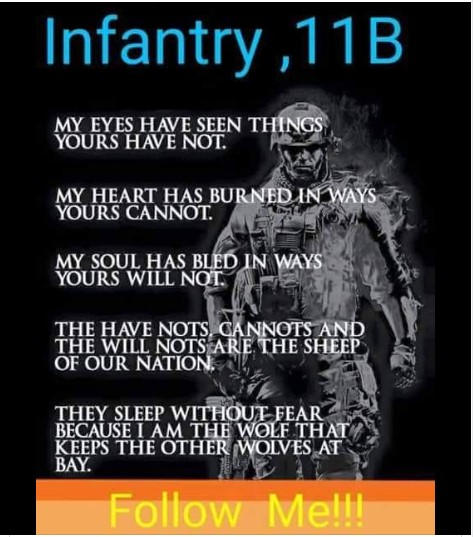
Nov???,1969
When we arrived in Pleiku around
6:00 am, we can hear mortars and larger artillery being fired for
what seemed like continuous action. We were in the highlands
which is colder that what we experienced upon arriving in
country.
??? Nov 1969.
Shortly after arrival, we were assigned to a division. I remember hoping to be assigned to the Big Red One. For some reason, I remember there was a lot of print in the Birmingham news about this division, but I was assigned to the 4th division. This was probably a bit of good luck. The Red 1 was in the deltas, rice paddies, and the 4th was in the mountains of Viet Nam. After orientation, we were helicoptered to a firebase. A Firebase is normally an area on a hilltop, which is circled by bunkers manned by 2-4 soldiers per bunker with razor wire as the outer perimeter. Inside the perimeter were command bunkers, mortars, and/or heavy artillery. Remember this is my first night in the field. We were assigned to a bunker for the night to help stand watch and wait for the morning. Since this was a temporary assignment until we could be deployed to our company, I had to make my bed on top of the bunker. Later, in the night all hell broke loose; shooting, flares in the sky, mortars going off, etc. Talk about fear, you never know what fear is until you experience life threatening events in an unknown country, with strangers you trust with your life and events happening to which you have no control. Training, and common-sense kick in but this is different from the training we received. I stayed outside the bunker trying to hide and see what was happening. Later, a soldier came running by saying the gooks (Viet Cong) were inside the perimeter. This entire time all I could do was shake; it was a wonder I was able to hold on to my rifle. Later, we found the reason for all the action. When mortars are shipped to the field, they come in a wooden box with each shell being wrapped in a container, which has a waxy product around it making the shell water resistance. This can be stripped and wrapped tightly into a candle. It seems someone had made a candle and either forgot about the candle or fell asleep catching the bunker on fire. This fire started the ammunition going off and started my first experience of what a gunfight could be like.
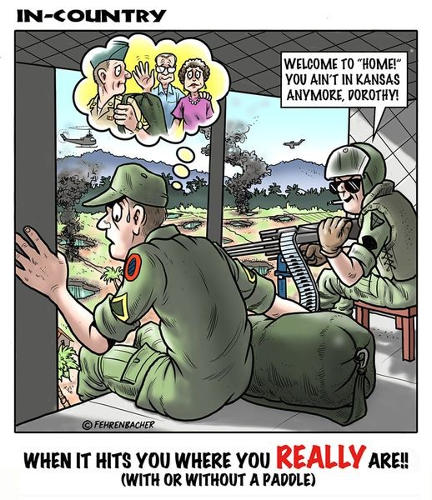
Welcome to Vietnam!! Sometime during this stay, there were interviews to enlist someone to join the LRP’s (Long Range Patrols), which are military units that operate behind enemy lines. I and several others volunteered and went through the interview process. The Sargent asked about our history and skills that would apply to his squad of LRP’s. For me hunting, football, sports, etc. others had similar skill but the one from Mississippi added bow hunting to his skills which gave him the advantage and the position. I heard a rumor that he did not survive the full year in Vietnam.
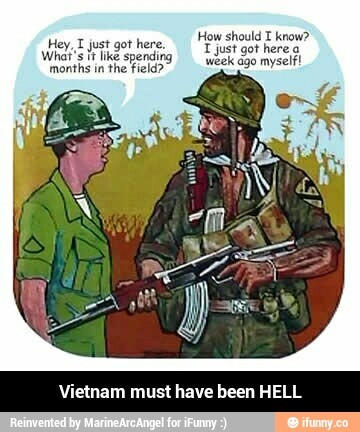
Nov 9, 1969
I am Cold. I have been assigned to the Highlands and it is a transition in temperature from Long Binh. Next week, we are to start a week of training before being assigned to a field unit. We have been introduced to the Malaria pill which is taken daily and two on Monday because this area has a high rate of malaria. As a group, we had to brush our teeth with a fluoride paste. Think of this, a bunch of soldiers around a trough being given instruction on how to brush our teeth by a NCO. Currently, we have mosquito nets around our beds to give us a little more protection. I have been hunting a ring for my wife but the PX does not have a good selection. This morning was strange, we woke up at 4:00 am and one of the guys turned his radio on and guess what was on, live football from the states. Thanks to the International Date Line for a taste of home. FYI there is a 13-hour time difference.
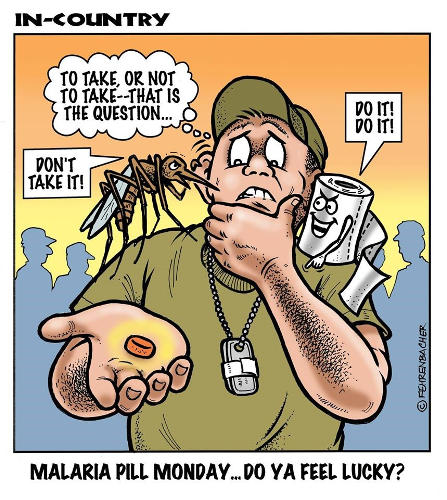
Nov 10, 1969
Training started today and I was able to send home a $100.00
money order and I was able to increase my wife’s allotment
to $230.00 per month. My needs are limited because of few
opportunities to spend it. I just got my address for the family
to write to me.
Nov 11, 1969
I was able to talk to a sergeant from my unit and he indicated it was a good unit, but they do a lot of patrols. Today, we went outside the perimeter to fire our weapons. This is the first time I had been able to associate with the Montagnard’s and the other locals. They were selling goods to the GI’s for one dollar- Pineapple, bracelet, cross necklace, bananas are all for one dollar each. The Pineapple was sweet and one of the best I have ever had.
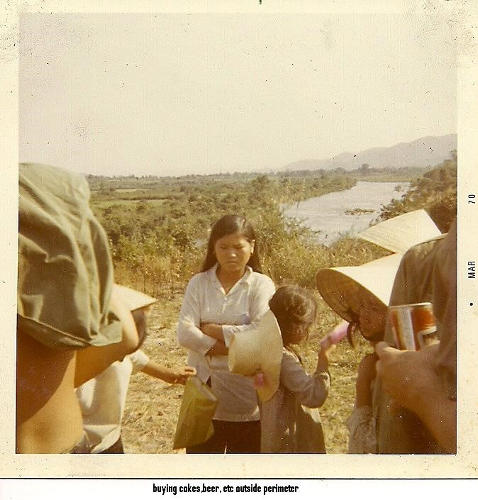
Photo by Randy Cox

Nov 13, 1969
Last night, we trained on the starlight scope. The starlight is a heavy scope which magnifies the night light allowing you to see items/people in the dark but because of the technology everything has a green tint. App. 200 of us went to the bunker line to fire one of three rifles with starlight scopes attached. I would have felt better if we had one per person, but they felt we would be protected by the soldiers on the bunker line.
|
|
Nov 14,1969
Yesterday, we went on a patrol, this was the first time I had seen banana trees, and a pineapple plant.
Nov 16, 1969
We are still waiting on the fire base to be deployed to our unit. From all indications my unit is one of the better ones, but I bet they said that to everyone.
??? D/1/8
We were given one hour to get our
gear ready for deployment. Upon arrival at the firebase, there
was a small meeting then we were assigned to a bunker. We pulled
guard duties at first then helped the mortar team until 1:00 am,
then guard duty from 1:30 am to 3:00 am and finally got to sleep
from 3:30 am to 6:00 am.
??? (D/1/8)
It is kind of unusual, we had a few incoming rounds, and everyone ran to their bunker and started returning fire. Our machine gunner ran out of ammo and I ran to resupply him. When I got back, he offered me and the other guy a beer because the firing was over. We sat behind the bunker drinking beer just moments after a brief firefight. It just goes to show we go from calm to hectic and back to calm in milliseconds. I never found out what happened which is probably just as well. The next day we went on an ambush; while we did not see any action the firebase did. They got 5 incoming mortar rounds with no injuries. This shows that sometimes it is safer in the field than on a firebase. I found out later the rounds came from Camp Radcliff, the American base, which is about 6 miles away. I was told they were either short rounds (falling short of their objective) or someone screwed up. This is called Friendly Fire.
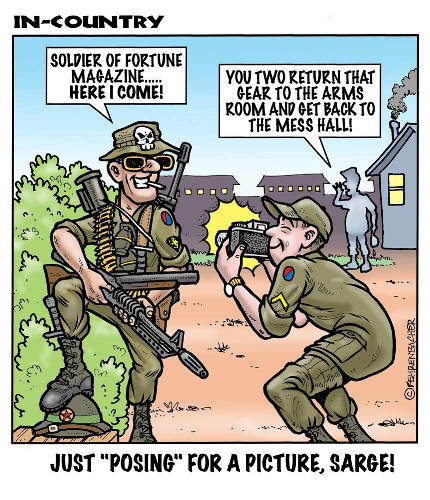
Nov 20, 1969
My writing might be a little shaky because of the large 8-inch guns, 105 or 155 howlers shaking the ground as they fire creating small dust storms. The sun is intense here in the Highland’s, and I have gotten blistered-lips, face, arms, etc. The sun might be so strong because we are at a higher altitude. One night at a base camp along one of the major supply routes, we were in a large tent for a movie or dinner that evening. When suddenly, we had incoming mortars, naturally everyone’s first response was to run out of the tent and toward the bunkers about 50 yards away. Picture this 20+ soldiers running for the tent opening then running in many different directions to a haven, their bunker. The first action was getting up and run but as that happened, I heard my First Sergeant tell my Lieutenant wait do not run, wait. Guess what I ran, not thinking of the consequence. As was often the case they have primary action then secondary action as everyone is in the open. This time I and others were lucky. They fired several mortar rounds and ran away. Now to the funny part, as I ran through the flap in the tent, I was side by side with another soldier, the problem was he wanted to go to the left and I wanted to go right. It was like the keystone cops. We would run 10-15 steps making a move in the direction we want to go only bounce off each other than do it again 10-15 steps farther. Quickly we made adjustment and went our respective directions. Think of the Keystone Cops! No harm was done that night.

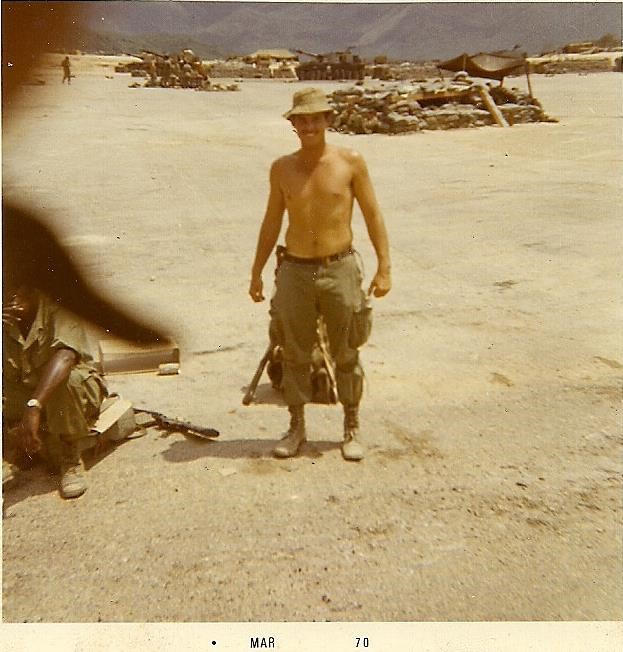
Randy Cox at firebase
Photo by Randy Cox
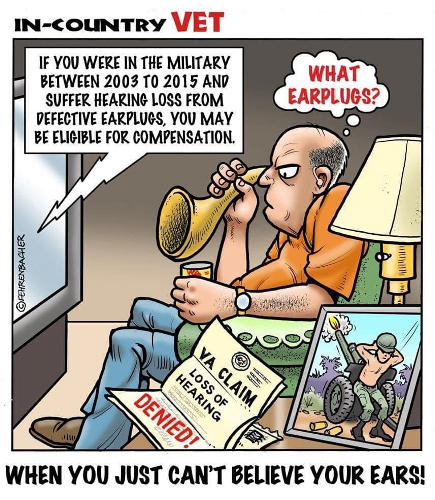
I remember the Platoon Sergeant greeting me when I first arrived in the field asking where I was from (common request to all FNG’s). When I replied ALABAMA, he said good most of the southern boys do well. Most of the highlands reminded me of the woods and forest of Alabama.
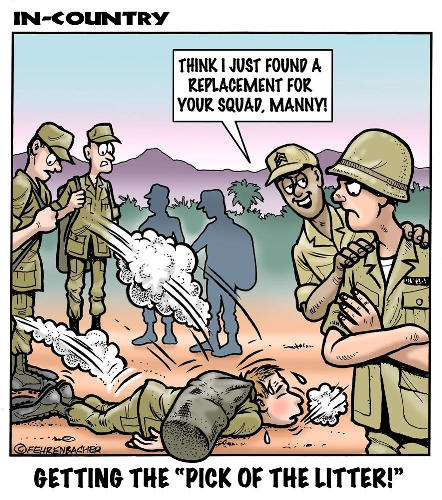
In one of our planning sessions, the captain/major (?) outlined our ambush location advising we should stay away from one area/hill because of the reported NVA regiment being active in the area. Strange!
|
|
Nov 25, 1969
One of my guys skipped out on me and now I am pulling guard duty in his place. He will have extra duties when I find him. I cannot remember if this is the same person, but I had problems with one soldier nicknamed “Roadrunner”. He got his name because when he walked point, we made good time. I had a policy that if you walked point, we wanted your backpack to be as light as possible for obvious reasons. We would share his food and water to make this possible.
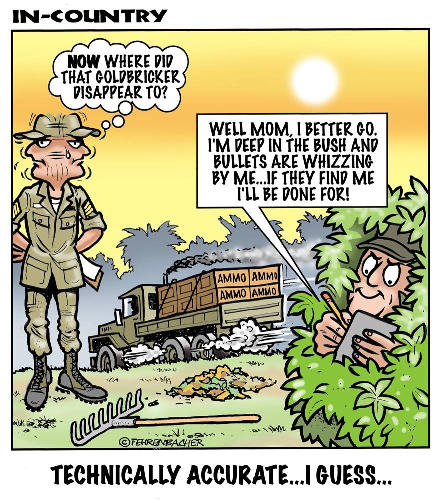
On one occasion we had to go on patrol, and I found him playing cards in a poncho tent which is not a problem except now we had to earn our keep. I said we need to go, and he indicated he was not going. Grabbing his foot, I pulled him out of the tent and held him as others tried to break us apart. He ran to the First Sargent while I followed. He got no sympathy from TOP which resulted on his going on patrol. I walked point for the platoon as he marched with the group. I think we healed our differences and were able to work as a team. Payday is coming up and I have $50.00 remaining and nowhere to spend it.

Event: Early in my year with D/1/8, I had a meeting with my squad and explained I was new, which they knew, and I needed their help learning the ropes. Later, we had to pull an ambush in the LARGE kill zone around the firebase which supplied artillery support for others thereby making us a target. If you can stop the artillery support for our troops this gives the enemy a greater chance of over running patrols and/or firebases. Because of this we had frequent patrols and ambushes operating in the area. Agent Orange like Roundup was a chemical weapon most notably used by the U.S. Military during the Vietnam War, classified as defoliant it was used to clear the area around the firebase. Its primary purpose was strategic. Early in my tour and my being a FNG, I had to rely on the others to help me understand the art of war. This base camp was beside a major supply route (road) and they kept the killing zone open. By killing zone, I mean an open area around the base camp or fire base which made it difficult for the enemy to mass troops to stage an attack and made it easy for us to fire from a fortified area without hitting an obstruction. This was normally kept clean by AGENT ORANGE or some other means of defoliate. One of my first acts as a sergeant in Viet Nam, was to take a squad on ambush or a LP (listening post).
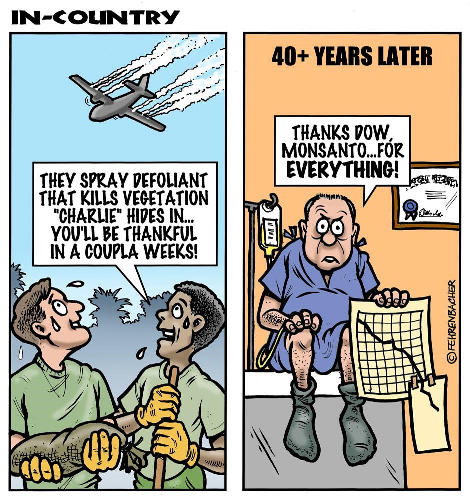
Later, that afternoon we left base camp to go out on our mission. We had a star light, a night vision telescope, weapons, and a few supplies. Little happened but I remember I talked too LOUD and the squad had to keep telling me to talk lower especially when I was on the radio. I remember the green hue of the star light telescope as I looked over the terrain trying to see movement and thanking GOD for not seeing any.
|
|

About this same time and maybe in this same firebase, the demolition team was to set off some charges. I cannot remember if it was a cache of explosives or if they were expanding the kill zone by blowing off some area. This was an advertised event because I remember standing on a bunker looking toward the area of the explosion. Never having been around a large explosion, I had no idea what was about to happen, but I wanted to see the fireworks. First it was the loud boom and then there was all kinds of rock and dirt heading my direction. All I can remember is seeing a large rock heading for my head. My response was spontaneous to duck, crawl and get off the bunker. This was accomplished without a hitch except teaching me a lesson; do not stand up looking at something being demolished.

Captured enemy ammunition
Photo by Randy Cox
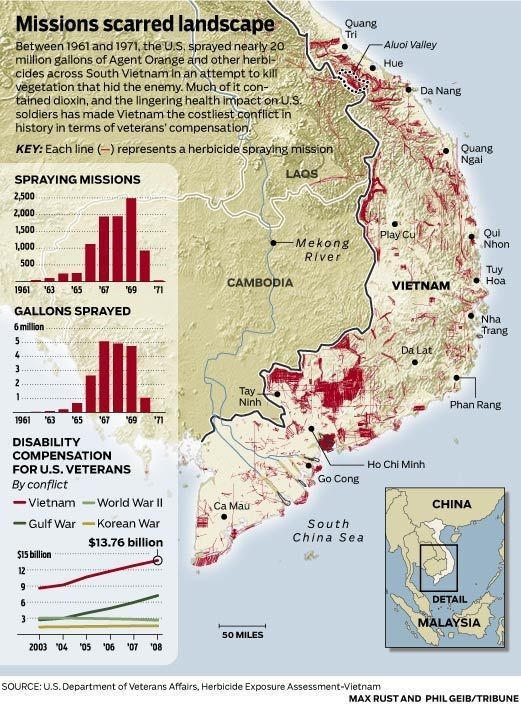
??? D/1/8
The day before, I got to ride on an APC. One of our convoy’s got ambushed so we jumped on top of the APC and away we went at 30-40 MPH. On the way a tank was stalled on the side of the road and we clipped their fender. If it had been 2-6 inches more toward the tank, we would have been thrown in front of the APC like riding a bicycle and hitting a large pothole. As we passed the tank, the APC driver looked at me and asked if we had hit the tank and I nodded yes. Why did we not ride inside the APX? If there had been a need to respond rapidly our actions would have been delayed by having to exit from a single small exit at the rear. Continuing to the ambush site we arrived after everything had cooled down. It seems several of the Gooks had attacked a convoy using small arms and RPG’s (rocket powered grenades).

Soviet designed RPG-2. In Vietnam these were usually known as B-40 rockets.
This is like a long pipe placed on the shoulder to which they inserted a rocket prior to firing at a target. The attack did not go very well for the Viet Cong as several were killed. This probably developed my initial understanding of the type of war we were involved in. First, we swept the area and by that time the dead had been piled up, diesel fuel poured on the bodies, and they were set on fire. Black smoke rose from the pile in the center of a tall weedy area. Not a pleasant site or thought.

M-113 Armored Personnel Carrier

Memory:
By this time, I had started to adjust to the climate and the
environment. The sun was intense, and I like others had sunburn
lips/sores which took weeks to heal. We got with our company and
we were meeting the group. One of my first meetings was with Doc
Hubbard who had several soldiers trying to get a shot of
penicillin off the record. You can guess why. My thoughts were
how and where did they have time for this in a war zone. At major
firebases, there would be roads circling the base camp which was
used by the locals and the military for transportation. For the
Army, we would be dropped off and given instruction as to where
to conduct an ambush. The locals, knowing there would be 7-12
soldiers going into the field they would approach soldiers
offering a little fun for $5.00. The locals and GI’s called
them Boom-Boom girls. Often, they would arrive on the back of a
small motorcycle driven by their pimp. During the year, one
soldier got the name of Cherry Boy. It seemed the Boom-Boom girls
really liked him and wanted to hook up, but he would not have
anything to do with them hence his nickname. FYI I was true and
wanted nothing to do with the Boom-Boom girls. Another term used
for the soldiers if they liked have time with many girls was,
Butterfly boy.
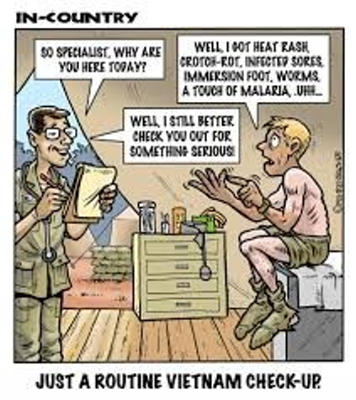
|
|

D/1/8 Firebase by hwy 19.
We had a meeting in the Command Post tent to discuss security, upcoming actions, ambushes, etc. While looking at a map of the area, we were shown a restricted area that we were to leave alone. Why? Because this was a known area of enemy activity. This always created mixed emotions. If the enemy was there, why not attack with all our resources instead of waiting on them. I cannot confirm it but later I heard they came out of the mountains and attacked and overran this firebase. This part always disturbed me.
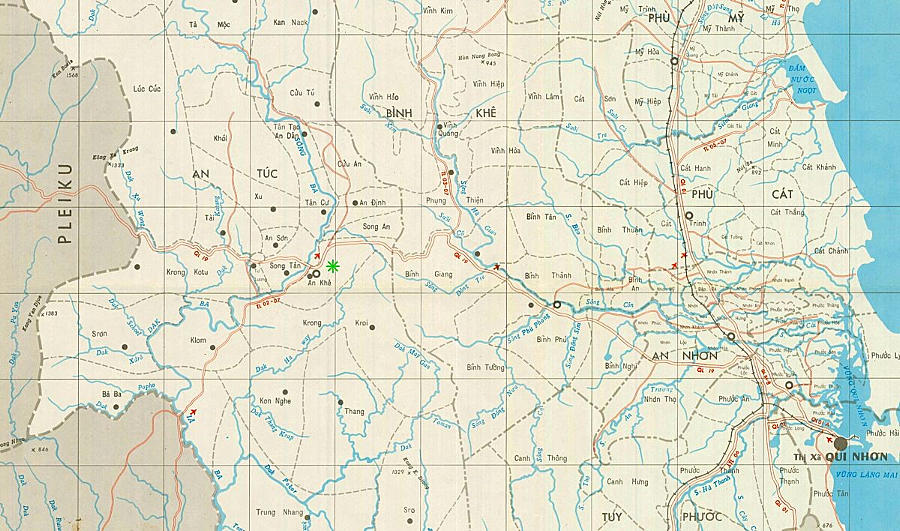
Highway QL-19 winding from east to west
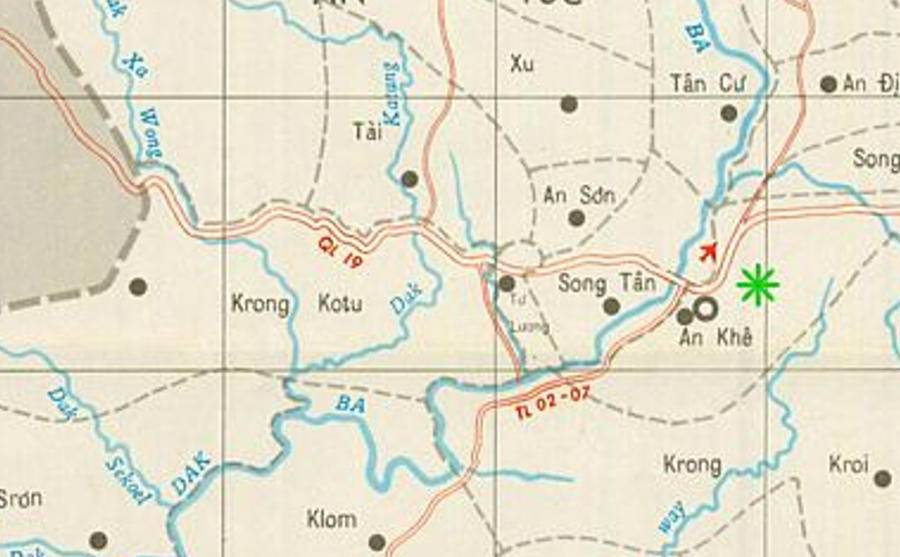
Highway QL-19 passing through An Khê on its way westward toward Pleiku
Disclaimer and Copyright Notice:
All images attributed to Randy Cox are copyright © Randall D. Cox 2022.
All "In Country" cartoons are from the In Country Facebook page and are copyright © Phil Fehrenbacher.
All images not attributed to
Randy Cox used in the presentation are done so under the Fair Use
doctrine,
and are not intended as infringement upon the copyright of the
original owner or creator of the image.
They are used here by Randy for non-profit educational purposes,
to help illustrate his story.
If you are the owner of an image
used in the presentation for which there is no credit given,
please contact the website
at c22inf@cox.net so we may credit you as the source, or remove the
image, according to your wishes.
Home | Photos | Battles & History | Current |
Rosters & Reports | Medal of Honor | Killed
in Action |
Personnel Locator | Commanders | Station
List | Campaigns |
Honors | Insignia & Memorabilia | 4-42
Artillery | Taps |
What's New | Editorial | Links |